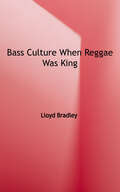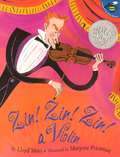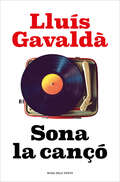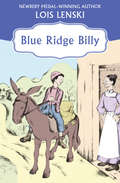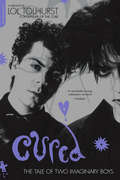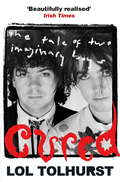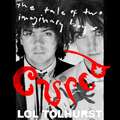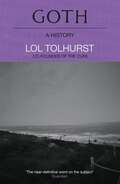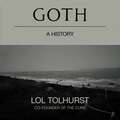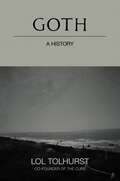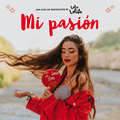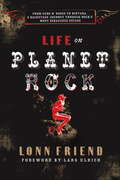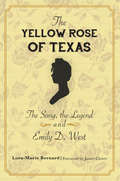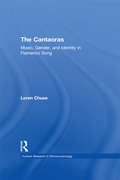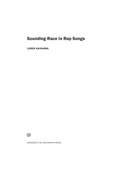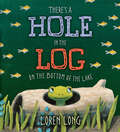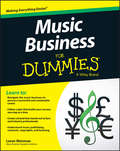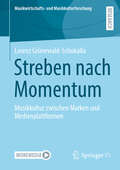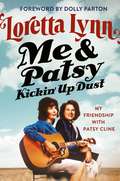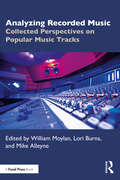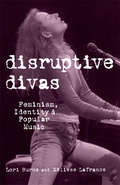- Table View
- List View
Bass Culture: When Reggae Was King
by Lloyd BradleyThe first major account of the history of reggae, black music journalist Lloyd Bradley describes its origins and development in Jamaica, from ska to rock-steady to dub and then to reggae itself, a local music which conquered the world. <p><p>There are many extraordinary stories about characters like Prince Buster, King Tubby and Bob Marley. But this is more than a book of music history: it relates the story of reggae to the whole history of Jamaica, from colonial island to troubled independence, and Jamaicans, from Kingston to London.
Zin! Zin! Zin! A Violin
by Lloyd MossUsing evocative poetic language, the author describes ten instruments coming on stage and performing, to the delight of the audience. [This text is listed as an example that meets Common Core Standards in English language arts for K-1 at http://www.corestandards.org.]
Sona la cançó
by Lluís GavaldàSona la cançó és una carta d'amor al poder evocador de les cançons, un llibre que emocionarà tots els que en algun moment de la nostra vida ens hem enamorat d'una melodia o d'una lletra. Des dels Beatles fins a David Bowie, passant per Bob Dylan i Bruce Springsteen, Lluís Gavaldà recull en aquest llibre la seixantena de cançons que han marcat la seva vida, aquelles que l'han fet plorar i riure, i també les que li hauria agradat compondre ell mateix. L'autor ens ho explica amb la cura i la delicadesa del qui s'ha nodrit de música des de ben petit. I és que aquest no és únicament un llibre per a melòmans, és també una declaració d'amor a la vida i un viatge sentimental escrit amb un estil extraordinàriament personal, capaç de ser divertit, tendre i apassionat al mateix temps.
Blue Ridge Billy
by Lois LenskiA young boy dreams of music and sunshine in the Great Smoky Mountains As far as Billy is concerned, there's no sight more beautiful than the sun setting over the Blue Ridge Mountains. When the day is done, he sneaks away from his work to watch the sun go down. If his father knew, he would call Billy lazy, but Mama would understand. She knows life in the mountains is hard and that there's no point in living if a person can't take time to appreciate what he has. Billy dreams of the day when he can pick up his fiddle and sing the folk songs of his people. Until then, he will be content with the sun. This beautifully written novel tells a story of simple fun and irresistible pleasures in 1 of the most beautiful regions in the United States.
Cured: The Tale of Two Imaginary Boys
by Lol Tolhurst"On our first day of school, Robert and I stood at the designated stop at Hevers Avenue with our mothers, and that's when we met for the very first time. We were five years old."So began a lifelong friendship that fourteen years later would result in the formation of The Cure, a quintessential post-punk band whose albums-such as Three Imaginary Boys, Pornography, and Kiss Me, Kiss Me, Kiss Me-remain among the best-loved and most influential of all time.As two of the first punks in the provincial English town of Crawley, Lol Tolhurst and Robert Smith didn't have it easy. Outsiders from the start, theirs was a friendship based initially on proximity and a shared love of music, from the punk that was raging in nearby London to the groundbreaking experimentation of David Bowie's "Berlin Trilogy." First known as The Easy Cure, they began playing in pubs and soon developed their own unique style and approach to songwriting, resulting in timeless songs that sparked a deep sense of identification and empathy in listeners, songs like "Boys Don't Cry," "Just Like Heaven," and "Why Can't I Be You?," spearheading a new subculture dubbed "Goth" by the press. The music of The Cure was not only accessible but also deeply subversive, challenging conventional notions of pop music and gender roles while inspiring a generation of devoted fans and a revolution in style.Cured is not only the first insider account of the early days of the band, it is a revealing look at the artistic evolution of the enigmatic Robert Smith, the iconic lead singer, songwriter, and innovative guitarist at the heart of The Cure. A deeply rebellious, sensitive, tough, and often surprisingly "normal" young man, Smith was from the start destined for stardom, a fearless non-conformist and provocateur who soon found his own musical language through which to express his considerable and unique talent.But there was also a dark side to The Cure's intense and bewildering success. Tolhurst, on drums and keyboards, was nursing a growing alcoholism that would destroy his place in The Cure and nearly end his life. Cured tells the harrowing and unforgettable story of his crash-and-burn, recovery, and rebirth.Intensely lyrical and evocative, gripping and unforgettable, Cured is the definitive story of a singular band whose legacy endures many decades hence, told from the point of view of a participant and eyewitness who was there when it happened-and even before it all began.
Cured: The Tale of Two Imaginary Boys
by Lol TolhurstThe inside story of The Cure'Beautifully realised' Irish TimesComing of age in Thatcher's Britain in the late 70s and early 80s was really tough, especially if you lived in Crawley. But against the grinding austerity, social unrest and suburban boredom, the spark of rebellion that was punk set alight three young men who would become one of the most revered and successful bands of their generation. The Cure.Cured is a memoir by Lol Tolhurst, one of the founding imaginary boys, who met Robert Smith when they were five. Lol threads the genesis of The Cure through his schoolboy years with Smith, the iconic leader of the group, and the band's most successful era in the 1980s. He takes us up to the present day, a riveting forty years since the band's inception.The band's journey to worldwide success is woven into a story not only of great highs and lows but also of love, friendship, pain, forgiveness and, ultimately, redemption on a beach in Hawaii.Cured highlights those parts of the creative journey that are not normally revealed to fans, incorporating many first-hand recollections around Lol's personal odyssey. From suburban London to the Mojave desert, Cured brings an acute eye for the times to bear on a lifelong friendship, with tales of addiction and despair along the way. Cured is the story of a timeless band and a life truly lived.
Cured: The Tale of Two Imaginary Boys
by Lol TolhurstComing of age in Thatcher's Britain in the late 70s and early 80s was really tough, especially if you lived in Crawley. But against the grinding austerity, social unrest and suburban boredom, the spark of rebellion that was punk set alight three young men who would become one of the most revered and successful bands of their generation. The Cure.Cured is a memoir by Lol Tolhurst, one of the founding imaginary boys, who met Robert Smith when they were six. Lol threads the genesis of The Cure through his schoolboy years with Smith, the iconic leader of the group, and the band's most successful era in the 1980s. He takes us up to the present day, a riveting forty years since the band's inception.The band's journey to worldwide success is woven into a story not only of great highs and lows but also of love, friendship, pain, forgiveness and, ultimately, redemption on a beach in Hawaii.Cured highlights those parts of the creative journey that are not normally revealed to fans, incorporating many first-hand recollections around Lol's personal odyssey. From suburban London to the Mojave desert, Cured brings an acute eye for the times to bear on a lifelong friendship, with tales of addiction and despair along the way. Cured is the story of a timeless band and a life truly lived.
Goth: A History
by Lol TolhurstGoth is an entertaining and evocative personal history of Goth music and culture, told by a true insider. Lol Tolhurst explores the godfathers of goth who established the genre's roots - THE CURE, which he co-founded with Robert Smith, contemporaries SIOUXSIE AND THE BANSHEES, BAUHAUS, JOY DIVISION - plus many more great bands that offered a place of refuge for the misfits of the 80s and ever since. Lol offers a fascinating deep dive into the movers and shakers of goth, imbued with his personal memories as well as those of fellow musicians, magicians and artists who make goth such an inevitable and enduring movement. Along the way he examines acts such as DEPECHE MODE and COCTEAU TWINS who helped the darkness expand. Finally, Tolhurst examines the legacy of goth music, and shows how its influence can still be seen to this day across music, film, TV, visual arts and social media. As thoughtful and thorough as it is utterly bewitching, Goth is a timeless testament to why Goth matters - and why it always will.
Goth: A History
by Lol TolhurstFollowing his memoir Cured, a fascinating deep dive into the dark Romanticism of Goth music, a misunderstood genre and culture, by co-founder of The Cure, Lol TolhurstGOTH is an entertaining and engaging historical memoir of the genre of Goth music and culture, exploring creative giants like The Cure, Siouxsie and the Banshees, Bauhaus, Joy Division and many more great bands that offered a place of refuge for the misfits of the 80s and ever since. Written by Lol Tolhurst, co-founder of The Cure, this book offers a fascinating deep dive into the movers and shakers of goth with stories and anecdotes from Tolhurst's personal memories as well as the musicians, magicians and artists who made it all happen - the people, places and events that made goth an inevitable and enduring movement . Starting with the Origins of Goth, Tolhurst explores early art and literature that inspired the genre and looks into the work of T.S Eliot, Edgar Allan Poe, Sylvia Plath, Albert Camus and more. He also outlines the path of Gothic forebears and shows how many musicians played in punk bands before transitioning into goth endeavours. Next, he introduces readers to the 'Architects of Darkness' - Bauhaus, Siouxsie and the Banshees, Joy Division and The Cure - the godfathers of goth who established the genre's roots. Following these early bands, Tolhurst discusses a group he calls the 'Spiritual Alchemists', consisting of bands like Depeche Mode, Cocteau Twins and more, who helped the darkness expand into the culture. He also tracks the expansion of the genre overseas, from England to New York, Los Angeles and beyond. Gothic fashion was an important part of the movement as well and Tolhurst discusses the clothing that accompanied and complemented the music. Finally, Tolhurst examines the legacy of goth music and shows how its influence can still be seen to this day across music, film, TV, visual arts, social media and so much more, finally concluding with 'Why Goth matters!'(P) 2023 Hachette Book Group
Goth: A History
by Lol TolhurstThe co-founder of The Cure and author of Cured delivers a fascinating deep dive into the dark romanticism of Goth music, a misunderstood genre and culture. GOTH is an entertaining and engaging historical memoir, and a journey through Goth music and culture, exploring creative giants like The Cure, Siouxsie and the Banshees, Bauhaus, Joy Division, and many more great bands that offered a place of refuge for the misfits of the &‘80s and ever since. Written by Lol Tolhurst, co-founder of The Cure, this book offers a riveting retrospective of the genre&’s iconic movers and shakers, infused with stories from Tolhurst&’s personal trove of memories, as well as anecdotes about the musicians, magicians, and artists who made it all happen—the people, places, and things that made Goth an inevitable and enduring movement. Starting with the Origins of Goth, Tolhurst explores early art and literature that inspired the genre and looks into the work of T.S Eliot, Edgar Allan Poe, Sylvia Plath, and Albert Camus, among others. He also outlines the path of Gothic Forebears and shows how many musicians played in punk bands before transitioning into Goth endeavors. Next, he introduces readers to the &“Architects of Darkness&”—Bauhaus, Siouxsie and the Banshees, Joy Division, and The Cure—the Godfathers of Goth who established the genre's roots. Following these early bands, Tolhurst discusses a group he calls the &“Spiritual Alchemists,&” consisting of bands like Depeche Mode, Cocteau Twins, and more, who helped the darkness expand into the culture. He also tracks the expansion of the genre overseas, from England to New York, Los Angeles, and beyond. Gothic fashion was an important part of the movement as well, and Tolhurst discusses the clothing that accompanied and complemented the music. Finally, Tolhurst examines the legacy of Goth music, and shows how its influence can still be seen to this day across music, film, TV, visual arts, social media, and more. As thoughtful and thorough as it is utterly bewitching, GOTH is a timeless testament to why Goth matters—and why it always will.
Lola Lolita. Nunca dejes de bailar: Los sueños de una muser (Lola Lolita #Volumen 1)
by Lola Moreno¡Lola Lolita, las aventuras de la estrella de Musical·ly! Nunca dejes de bailar con @lolaloliitaaa Lola está de los nervios. Hoy empieza clases en un nuevo insti superguay que lo tiene todo... ¡menos a sus amigas! El primer día conoce a Lucia, Ana y Carla, tres chicas que parecen tener algo en común con Lola: adoran a David Peluso, un youtuber guapísimo con una voz alucinante. ¡Que coincidencia! A partir de aquí empiezan a ser superamigas y crean un club de baile para montar la coreografía estrella del festival de navidad. Pronto todos en el insti descubrirán que Lola es una superestrella de Musical·ly y vivirán muchas aventuras hasta el día de la coreo final. ¿Saldrá todo como tenían previsto?
Mi pasión: Una guía de inspiración by Lola Lolita (Lola Lolita #Volumen 3)
by Lola MorenoMi pasión. Una guía de inspiración by Lola Lolita. Lola Lolita demuestra cada día en sus redes por qué es una inspiración para sus miles de fans. Lola es capaz de transmitir su carisma, su estilo y su pasión en todo lo que comparte con sus seguidores, ya sean bailes, outfits, frases o fotos inspiradoras. En este libro, Lola nos descubre su lado más personal, sus sueños, sus ideas y su visión particular del mundo que nos rodea. Una guía de estilo para descubrir los secretos de esta influencer, y todo aquello que la convierte en un icono generacional. Déjate inspirar por Lola Lolita.
Nunca dejes de sonreír: Los sueños de una muser (Lola Lolita #Volumen 3)
by Lola MorenoLola Lolita, ¡la tercera aventura de la estrella de Tik Tok! Nunca dejes de sonreír con @lolaloliitaaa Hay una pequeña cosita inevitable que siempre hay que sufrir antes de poder irte vacaciones... ¡los exámenes de final de curso! ¡Glups! Y en el caso de Lola este año no eran lo que se dice unos exámenes normalitos, si no la temible selectividad. ¡Doble glups! Sumergida entre apuntes, Lola no paraba de pensar en todas las cosas guays que haría durante las vacaciones: tomar el sol, navegar en barquito, hacer paddle surf… Y por fin llegó el día. Carla, Ana, Lucia y ella estaban ready para pasar el mejor verano de su vida. ¡No tenían ni idea de que aquellas vacaciones serían mucho más moviditas de lo que jamás habrían imaginado!¡Menudas vacaciones más top! {Nunca dejes de sonreír con @lolaloliitaaa}
Nunca dejes de soñar: La historia de una muser (Lola Lolita #Volumen 2)
by Lola MorenoLola Lolita, ¡las aventuras de la estrella de Musical·ly! Nunca dejes de soñar con @lolaloliitaaa Hoy empieza un nuevo curso y Lola se muere de ganas por reencontrarse con los Tumblr, ¡su grupito de baile! Este año lo van a hacer todavía mejor, todos tienen un montón de ideas para organizar un espectáculo increíble. Lo que no se esperan es lo que va a suceder... Valeria, la nueva compañera del insti, se va a convertir en su máxima rival. Resulta que Valeria baila desde pequeña y está montando un baile para competir con Lolita y su grupo... ¡la disputa entre musers está asegurada! ¿Quién será la más votada?
Life on Planet Rock
by Lonn FriendFor fans of heavy metal music, RIP magazine was a cultural touchstone, every bit as crucial in its day as Kerrang, NME or Rolling Stone. Lonn Friend, RIP's legendary editor, helped launch and revive the careers of innumerable acts - including Guns n' Roses, Metallica and Pearl Jam - and created some of the most enduring rock journalism of the decade, rivaling the best work of Lester Bangs and Cameron Crowe. In Life on Planet Rock, Friend describes in lucid and lurid detail how he became the Zelig-like chronicler of the biggest musical moments of the 80s and 90s, providing revealing portraits of artists as varied as Gene Simmons, Alice Cooper, Axl Rose, Jon Bon Jovi, Kurt Cobain, and Steven Tyler, among others. A candid and humorous memoir to appeal to fans of Motley Crue's The Dirt and Seb Hunter's Hell Bent For Leather, Life on Planet Rock is a wormhole back to a fast-moving time in music, filled with Dionysian excess and bombastic egos, told as only someone who was there through it all could tell it.
The Yellow Rose of Texas: The Song, the Legend and Emily D. West
by Lora-Marie BernardA journalist searches for the truth behind the traditional folk song, and a free black woman’s role in the Texas Revolution.The legend of the Yellow Rose of Texas holds an indisputable place in Lone Star culture, tethered to a familiar song that has served as a Civil War marching tune, a pop chart staple, and a halftime anthem. Almost two centuries of Texas mythmaking successfully muddled fact with fable in song, and the true story of Emily D. West remains mired in dispute and unrecognizable beneath the tales that grew up around it. The complete truth may never be recovered, but in this book Lora-Marie Bernard seeks an honest account honoring the grit and determination that brought a free black woman from the abolitionist riots of Connecticut to the thick of a bloody Texas revolution. A Lone Star native who grew up immersed in the Yellow Rose legend, Bernard also traces other stories that legend has obscured, including the connection between Emily D. West and plans for a free black colony in Texas.Includes illustrations
Cantaoras: Music, Gender and Identity in Flamenco Song (Current Research in Ethnomusicology: Outstanding Dissertations #7)
by Loren ChuseThis book provides an in-depth ethnographic investigation of the greatly underestimated and underappreciated contributions of women singers, the cantaoras, to the creation, transmission and innovation in flamenco song. Situating the study of flamenco in the context of social and political currents that have shaped twentieth-century Spain, and drawing on interviews with the cantaoras themselves, Loren Chuse shows how flamenco is a complex of cultural practices at once musical, physical, verbal and social, involving the expression and negotiation of complex multi-layered identities, including notions of Andalusian, regional, gypsy and gender identity. Chuse shows how women are engaged in the formation of flamenco today, and how they respond to the balance and tensions between tradition and innovation. In so doing, she encourages a deeper appreciation of flamenco and initiates new approaches within ethnomusicology, feminist scholarship, flamenco, gender and popular music studies.
Sounding Race in Rap Songs
by Loren KajikawaAs one of the most influential and popular genres of the last three decades, rap has cultivated a mainstream audience and become a multimillion-dollar industry by promoting highly visible and often controversial representations of blackness. Sounding Race in Rap Songs argues that rap music allows us not only to see but also to hear how mass-mediated culture engenders new understandings of race. The book traces the changing sounds of race across some of the best-known rap songs of the past thirty-five years, combining song-level analysis with historical contextualization to show how these representations of identity depend on specific artistic decisions, such as those related to how producers make beats. Each chapter explores the process behind the production of hit songs by musicians including Grandmaster Flash and the Furious Five, The Sugarhill Gang, Run-D.M.C., Public Enemy, N.W.A., Dr. Dre, and Eminem. This series of case studies highlights stylistic differences in sound, lyrics, and imagery, with musical examples and illustrations that help answer the core question: can we hear race in rap songs? Integrating theory from interdisciplinary areas, this book will resonate with students and scholars of popular music, race relations, urban culture, ethnomusicology, sound studies, and beyond.
There's a Hole in the Log on the Bottom of the Lake
by Loren LongBuilt for giggles and fun read-alouds, this classic children's song has been adapted by #1 New York Times bestselling illustrator of Love and Otis, Loren Long!"One to visit again and again..." --Publishers WeeklyThere's a log on the bottom of the lakeThere's a log on the bottom of the lakeThere's a log?There's a log!There's a log on the bottom of the lake.But it turns out there's a a whole lot more than just a log on the bottom of this lake!A cumulative text featuring repetition and tongue-twisters combine with gorgeous illustrations from New York Times bestselling illustrator Loren Long for a book kids will clamor for at storytime. Endpapers include sheet music and lyrics for kids and parents to have their own singalong!
Music Business For Dummies
by Loren Weismanaunting than before. This guide gives you a roadmap around the landmines, and provides expert advice for starting out on the right foot.Find the right players, agents, and business managersMake more money from your work with smart distributionBuild your brand and get people talking about youGet gigs, go on tour, and keep on growingIf music is your calling, you need to plan your career in a way that sets you up for success from the very beginning. Put the right people in place, get the most out of your investments, and learn how to work the crowd both virtually and in person. Music Business For Dummies is your companion on your journey to the music career you want.
Streben nach Momentum: Musikkultur zwischen Marken und Medienplattformen (Musikwirtschafts- und Musikkulturforschung)
by Lorenz Grünewald-SchukallaSeit der industriellen Produktion von Notendrucken nutzen Unternehmen Musik, um ihre Marken zu entwickeln und zu etablieren. Diese Studie beleuchtet die vielfältigen Formen der Verbindung von Marken und Musik, von den gebrandeten Radioshows im frühen 20. Jahrhundert bis hin zu den modernen, integrierten Musik-Dachmarken von Red Bull, der Telekom oder Seat. Sie zeigt, wie die Beziehungen zwischen Marken und Musik im Verlauf der Geschichte verändert wurden. Dabei lenkt sie erstmals den Blick auf die Rolle neuer Medienentwicklungen in diesem Prozess. Anhand der innovativen Methode einer digitalen, fokussierten und verteilten Ethnographie wird die besondere Rolle digitaler Plattformen für gegenwärtige gebrandete Musikkultur in den Blick genommen. Der Autor zeigt anschaulich, wie Markenunternehmen Orte und Events so arrangieren, dass medienbezogene Praktiken auf Plattformen ausgerichtet werden. So steigern Unternehmen die Wahrscheinlichkeit gebrandeter Kommunikationsströme und erzeugen ein „Momentum“, das den Wert einer Marke, die Karrieren von Musikschaffenden, aber auch gewöhnliche Musikerfahrung beflügeln kann. In der Summe führt dies zu einer neuen Musikkultur, einer Musikkultur zwischen Marken und Medienplattformen. In dieser können zwar viele an Musikkultur teilhaben, sind jedoch dem Zwang ausgesetzt, etwas zum Momentum einer Marke beizutragen.
Effects of Opera Music from Brain to Body: A Matter of Wellbeing (Neurocultural Health and Wellbeing)
by Lorenzo Lorusso Michele Augusto Riva Vittorio Alessandro SironiThis book explores the connection between melodrama and medicine from multiple perspectives. Neuroscientists study the relationship between opera and brain functioning in the light of new findings in the fields of neurophysiology, neuroimaging, cognitive science and neuro-musicology; clinicians investigate the therapeutic potential of music, especially in the field of treatment and rehabilitation of individuals with neurodegenerative diseases; medical historians analyse the representation of diseases and those who cure diseases within operas; occupational doctors report descriptions of diseases that affect workers in the opera world and particularly focus on psychiatric and psychological alterations. Opera, with its instrumental and vocal accompaniment, is considered the most complete form of theatrical performance. However, little is known about the mechanisms of brain activity under the influence of melodrama on singers, musicians, and listeners. The use of neuroimaging techniques has enabled a better understanding of the neuronal mechanisms and circuits involved during an opera performance. Over the past 20 years, melodrama has increasingly been used as a therapeutic approach in various neurological and neuropsychiatric pathologies, such as depression, cognitive impairment, and even coma. The book also discusses the ways in which melodrama affects professionals involved in music and interventions to reduce or alleviate occupational diseases, leading to improved health and higher life satisfaction. The ultimate goal is to improve therapeutic interventions in neurological diseases and professional disorders, relying on solid neuroscientific data. This book will be of great interest to neurologists, neurobiologists, psychiatrists, occupational doctors and therapists in music.
Me & Patsy Kickin' Up Dust: My Friendship with Patsy Cline
by Loretta Lynn Patsy Lynn RussellMe & Patsy Kickin' Up Dust shares the"important and inspiring" (Miranda Lambert) never-before-told complete story of the remarkable relationship between country music icons Patsy Cline and Loretta Lynn. Loretta Lynn and the late Patsy Cline are legends--country icons and sisters of the heart. For the first time ever Loretta tells their story: a celebration of their music and their relationship up until Patsy's tragic and untimely death.Full of laughter and tears, this eye-opening, heartwarming memoir paints a picture of two stubborn, spirited country gals who'd be damned if they'd let men or convention tell them how to be. Set in the heady streets of the 1960s South, this nostalgia ride shows how Nashville blossomed into the city of music it is today. Tender and fierce, Me & Patsy Kickin' Up Dust is an up-close-and-personal portrait of a friendship that defined a generation and changed country music indelibly--and a meditation on love, loss and legacy.
Analyzing Recorded Music: Collected Perspectives on Popular Music Tracks
by Lori Burns William Moylan Mike AlleyneAnalyzing Recorded Music: Collected Perspectives on Popular Music Tracks is a collection of essays dedicated to the study of recorded popular music, with the aim of exploring "how the record shapes the song" (Moylan, Recording Analysis, 2020) from a variety of perspectives. Introduced with a Foreword by Paul Théberge, the distinguished editorial team has brought together a group of reputable international contributors to write about a rich collection of recordings. Examining a diverse set of songs from a range of genres and points in history (spanning the years 1936–2020), the authors herein illuminate unique attributes of the selected tracks and reveal how the recording develops the expressive content of song performance. Analyzing Recorded Music will interest all those who study popular music, cultural studies, and the musicology of record production, as well as to popular music listeners.
Disruptive Divas: Feminism, Identity and Popular Music (Studies In Contemporary Music And Culture Ser.)
by Lori Burns Melisse LafranceDisruptive Divas focuses on four female musicians: Tori Amos, Courtney Love, Me'Shell Ndegéocello and P. J. Harvey who have marked contemporary popular culture in unexpected ways have impelled and disturbed the boundaries of "acceptable" female musicianship.
